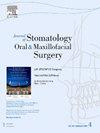磁共振神经造影:恶性腮腺肿瘤面神经侵犯的术前评估。
IF 2
3区 医学
Q2 DENTISTRY, ORAL SURGERY & MEDICINE
Journal of Stomatology Oral and Maxillofacial Surgery
Pub Date : 2025-04-10
DOI:10.1016/j.jormas.2025.102329
引用次数: 0
摘要
背景:腮腺恶性肿瘤的面神经侵犯(FNI)显著影响治疗结果和预后。准确的术前FNI评估对手术计划和肿瘤分期至关重要。传统的成像方式往往不能可视化面神经和评估FNI。目的:评价磁共振神经成像(MRN)检测腮腺恶性肿瘤FNI的预测效果,为肿瘤分期和治疗决策提供依据。方法:回顾性分析腮腺恶性肿瘤患者28例。mri显示腮腺内面神经与肿瘤的关系。然后用MRN结果预测FNI并重新评估临床T分期。使用手术记录进行验证。采用卡方检验和净再分类改进(NRI)进行统计分析。结果:腮腺内面神经主干(颞面)和颈面(颈面)显示率分别为100%、96.4%和96.4%。23例(82.1%)符合手术表现(P < 0.01)。mrn提示浸润比面瘫更能预测FNI。22.7%的病例低估了T4a期肿瘤(n = 5), MRN对临床T分期的评价优于无MRN (NRI bb0 0, Z = 2.17, P = 0.03)。结论:MRN可为腮腺恶性肿瘤的FNI预测提供有价值的信息,从而改善肿瘤分期,辅助治疗决策。本文章由计算机程序翻译,如有差异,请以英文原文为准。
Magnetic resonance neurography: Preoperative assessment of facial nerve invasion in malignant parotid gland tumors
Backgrounds
Facial nerve invasion (FNI) in parotid gland malignancies significantly impacts treatment outcomes and prognosis. Accurate preoperative assessment of FNI is crucial for surgical planning and tumor staging. Conventional imaging modalities often fail to visualize the facial nerve and assess FNI.
Objects
This study aims to evaluate the predictive efficacy of magnetic resonance neurography (MRN) in detecting FNI in parotid gland malignancies, with the goal of aiding tumor staging and treatment decision-making.
Methods
28 patients with parotid gland malignancies were included. MRN was utilized to visualize the intraparotid facial nerve and determine its relationship with the tumor. MRN results were then used to predict FNI and re-evaluate the clinical T stage. Surgical records were used for validation. Statistical analysis was performed using chi-square tests and net reclassification improvement (NRI).
Results
The display rates of the main trunk and other divisions (temporofacial and cervicofacial) of the intraparotid facial nerve were 100 %, 96.4 %, and 96.4 %, respectively. Twenty-three patients (82.1 %) matched the surgical findings (P < 0.01). MRN-indicated infiltration performed better than facial paralysis in predicting FNI. Tumors of stage T4a were underestimated in 22.7 % of cases (n = 5), and evaluation of clinical T stage with MRN was superior to that without MRN (NRI > 0, Z = 2.17, P = 0.03).
Conclusions
MRN can provide valuable information for predicting FNI in parotid gland malignancies, thereby improving tumor staging and aiding treatment decision-making.
求助全文
通过发布文献求助,成功后即可免费获取论文全文。
去求助
来源期刊

Journal of Stomatology Oral and Maxillofacial Surgery
Surgery, Dentistry, Oral Surgery and Medicine, Otorhinolaryngology and Facial Plastic Surgery
CiteScore
2.30
自引率
9.10%
发文量
0
审稿时长
23 days
 求助内容:
求助内容: 应助结果提醒方式:
应助结果提醒方式:


